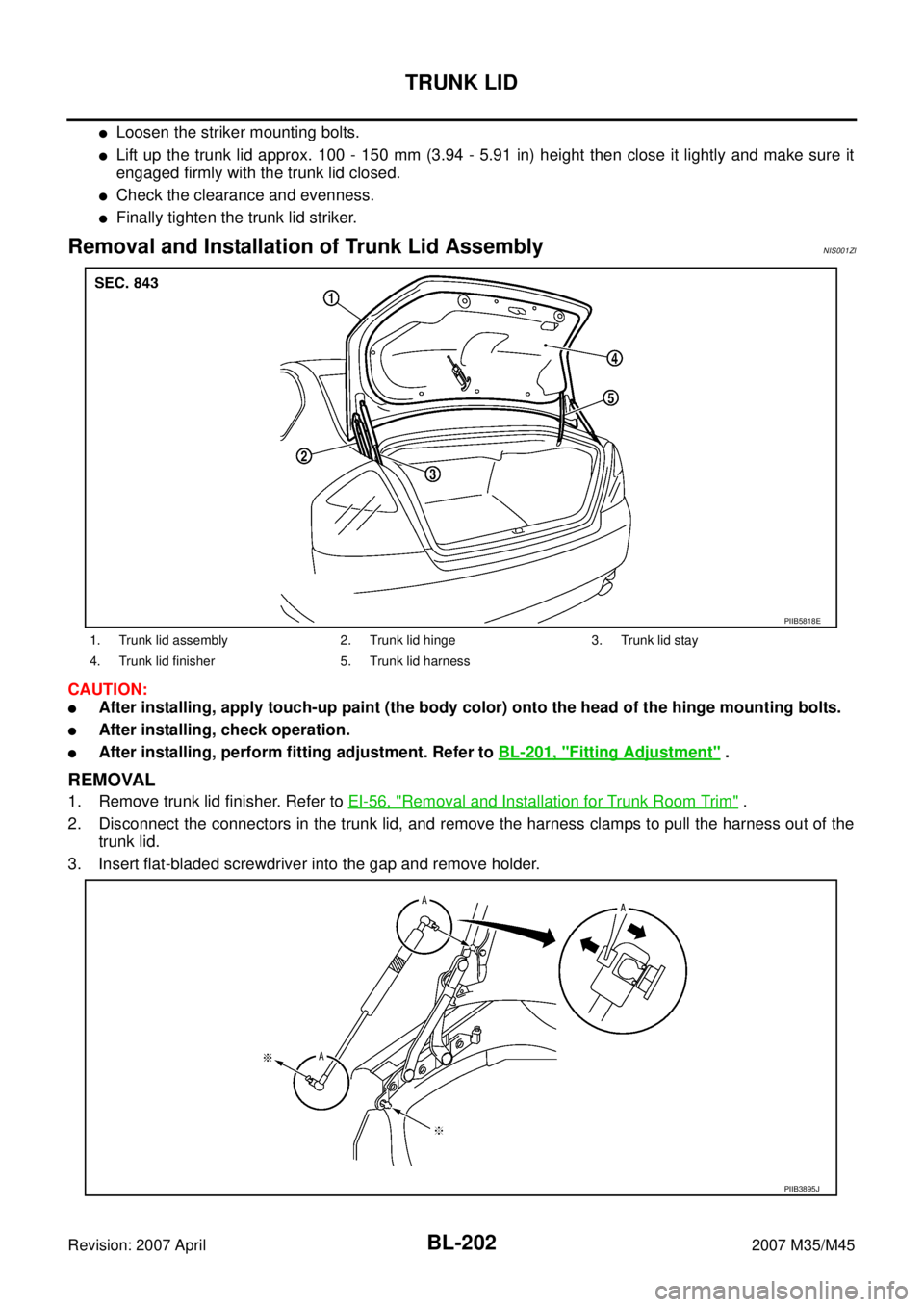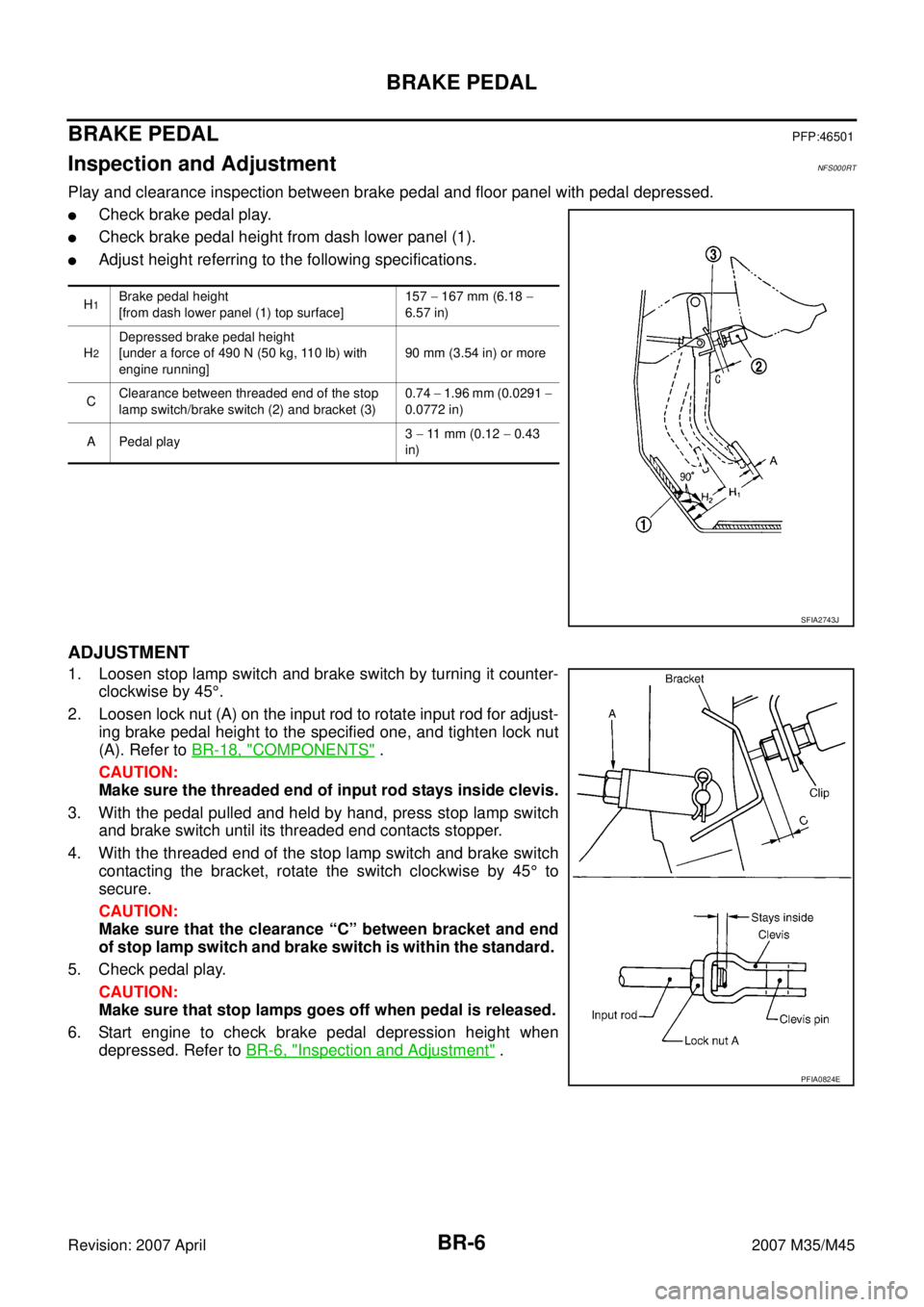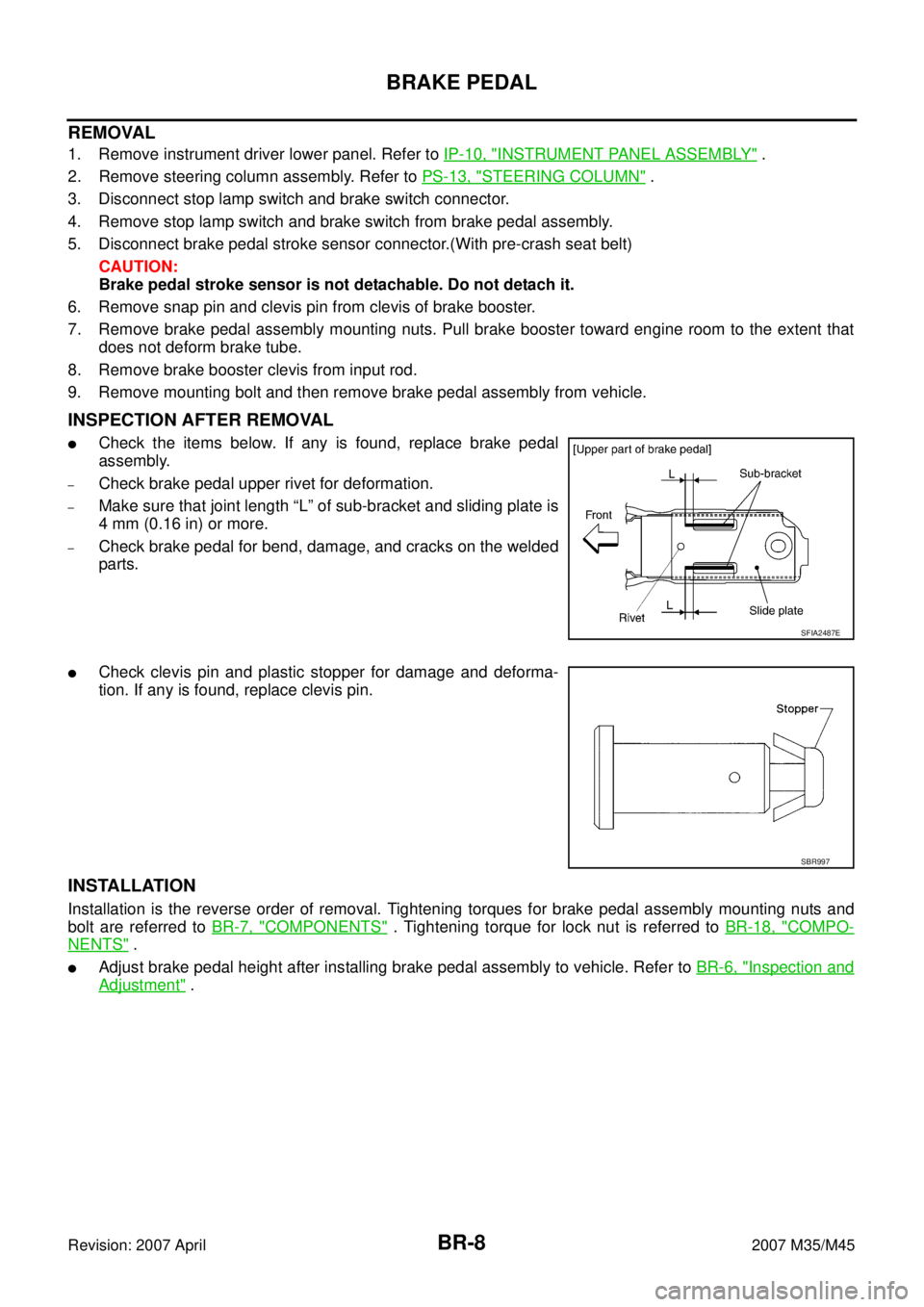Page 1135 of 4647

BL-202
TRUNK LID
Revision: 2007 April2007 M35/M45
�Loosen the striker mounting bolts.
�Lift up the trunk lid approx. 100 - 150 mm (3.94 - 5.91 in) height then close it lightly and make sure it
engaged firmly with the trunk lid closed.
�Check the clearance and evenness.
�Finally tighten the trunk lid striker.
Removal and Installation of Trunk Lid AssemblyNIS001ZI
CAUTION:
�After installing, apply touch-up paint (the body color) onto the head of the hinge mounting bolts.
�After installing, check operation.
�After installing, perform fitting adjustment. Refer to BL-201, "Fitting Adjustment" .
REMOVAL
1. Remove trunk lid finisher. Refer to EI-56, "Removal and Installation for Trunk Room Trim" .
2. Disconnect the connectors in the trunk lid, and remove the harness clamps to pull the harness out of the
trunk lid.
3. Insert flat-bladed screwdriver into the gap and remove holder.
1. Trunk lid assembly 2. Trunk lid hinge 3. Trunk lid stay
4. Trunk lid finisher 5. Trunk lid harness
PIIB5818E
PIIB3895J
Page 1137 of 4647
BL-204
TRUNK LID
Revision: 2007 April2007 M35/M45
Removal and Installation of Trunk Lid LockNIS001ZK
REMOVAL
1. Remove the trunk lid finisher. Refer to EI-56, "Removal and Installation for Trunk Room Trim" .
2. Remove the trunk lid emergency opener lever.
3. Disconnect the trunk lid opener cable.
4. Disconnect the trunk lid.
5. Remove the mounting bolts, and remove the trunk lid lock.
INSTALLATION
1. Install in the reverse order of removal.
2. After installing, close the trunk lid height. Perform the lock and surface height adjustment. Refer to BL-
201, "Fitting Adjustment" .
3. After installing, check the operation.
1. Trunk lid lock 2. Trunk lid opener cable 3. Trunk lid key cylinder
4. Trunk lid opener switch 5. Trunk lid emergency opener lever
PIIB5819E
PIIB5820E
Page 1138 of 4647
TRUNK LID
BL-205
C
D
E
F
G
H
J
K
L
MA
B
BL
Revision: 2007 April2007 M35/M45
Removal and Installation of Trunk Lid StrikerNIS001ZL
REMOVAL
1. Remove the trunk rear plate and trunk rear finisher. Refer to EI-
56, "Removal and Installation for Trunk Room Trim" .
2. Remove the mounting bolts, and remove the striker from the
trunk lock support.
INSTALLATION
1. Install in the reverse order of removal.
2. After installing, close the trunk lid height. Perform the lock and surface height adjustment. Refer to BL-
201, "Fitting Adjustment" .
3. After installing, check the operation.
PIIB3914J
Page 1273 of 4647

BR-6
BRAKE PEDAL
Revision: 2007 April2007 M35/M45
BRAKE PEDALPFP:46501
Inspection and AdjustmentNFS000RT
Play and clearance inspection between brake pedal and floor panel with pedal depressed.
�Check brake pedal play.
�Check brake pedal height from dash lower panel (1).
�Adjust height referring to the following specifications.
ADJUSTMENT
1. Loosen stop lamp switch and brake switch by turning it counter-
clockwise by 45°.
2. Loosen lock nut (A) on the input rod to rotate input rod for adjust-
ing brake pedal height to the specified one, and tighten lock nut
(A). Refer to BR-18, "
COMPONENTS" .
CAUTION:
Make sure the threaded end of input rod stays inside clevis.
3. With the pedal pulled and held by hand, press stop lamp switch
and brake switch until its threaded end contacts stopper.
4. With the threaded end of the stop lamp switch and brake switch
contacting the bracket, rotate the switch clockwise by 45° to
secure.
CAUTION:
Make sure that the clearance “C” between bracket and end
of stop lamp switch and brake switch is within the standard.
5. Check pedal play.
CAUTION:
Make sure that stop lamps goes off when pedal is released.
6. Start engine to check brake pedal depression height when
depressed. Refer to BR-6, "
Inspection and Adjustment" .
H1Brake pedal height
[from dash lower panel (1) top surface]157 − 167 mm (6.18 −
6.57 in)
H
2
Depressed brake pedal height
[under a force of 490 N (50 kg, 110 lb) with
engine running]90 mm (3.54 in) or more
CClearance between threaded end of the stop
lamp switch/brake switch (2) and bracket (3)0.74 − 1.96 mm (0.0291 −
0.0772 in)
A Pedal play3 − 11 mm (0.12 − 0.43
in)
SFIA2743J
PFIA0824E
Page 1275 of 4647

BR-8
BRAKE PEDAL
Revision: 2007 April2007 M35/M45
REMOVAL
1. Remove instrument driver lower panel. Refer to IP-10, "INSTRUMENT PANEL ASSEMBLY" .
2. Remove steering column assembly. Refer to PS-13, "
STEERING COLUMN" .
3. Disconnect stop lamp switch and brake switch connector.
4. Remove stop lamp switch and brake switch from brake pedal assembly.
5. Disconnect brake pedal stroke sensor connector.(With pre-crash seat belt)
CAUTION:
Brake pedal stroke sensor is not detachable. Do not detach it.
6. Remove snap pin and clevis pin from clevis of brake booster.
7. Remove brake pedal assembly mounting nuts. Pull brake booster toward engine room to the extent that
does not deform brake tube.
8. Remove brake booster clevis from input rod.
9. Remove mounting bolt and then remove brake pedal assembly from vehicle.
INSPECTION AFTER REMOVAL
�Check the items below. If any is found, replace brake pedal
assembly.
–Check brake pedal upper rivet for deformation.
–Make sure that joint length “L” of sub-bracket and sliding plate is
4 mm (0.16 in) or more.
–Check brake pedal for bend, damage, and cracks on the welded
parts.
�Check clevis pin and plastic stopper for damage and deforma-
tion. If any is found, replace clevis pin.
INSTALLATION
Installation is the reverse order of removal. Tightening torques for brake pedal assembly mounting nuts and
bolt are referred to BR-7, "
COMPONENTS" . Tightening torque for lock nut is referred to BR-18, "COMPO-
NENTS" .
�Adjust brake pedal height after installing brake pedal assembly to vehicle. Refer to BR-6, "Inspection and
Adjustment" .
SFIA2487E
SBR997
Page 1286 of 4647
BRAKE BOOSTER
BR-19
C
D
E
G
H
I
J
K
L
MA
B
BR
Revision: 2007 April2007 M35/M45
4. Install brake pedal bracket mounting nuts and bolt, and tighten them to the specified torque. Refer to BR-
7, "COMPONENTS" .
5. Install vacuum hose into brake booster. Refer to BR-21, "
Removal and Installation" .
6. Install master cylinder to booster assembly. Refer to BR-14, "
Removal and Installation" .
7. Adjust the brake pedal height and the play of the brake pedal. Refer to BR-6, "
ADJUSTMENT" .
8. Tighten lock nut of input rod to the specified torque. Refer to BR-18, "
COMPONENTS" .
9. Connect front left brake tube to ABS actuator and electric unit (control unit). Refer to BR-11, "
Hydraulic
Circuit" .
10. Install cowl top. Refer to EI-18, "
Removal and Installation" .
11. Refill new brake fluid and bleed air. Refer to BR-10, "
Bleeding Brake System" .
Page 1301 of 4647

BR-34
SERVICE DATA AND SPECIFICATIONS (SDS)
Revision: 2007 April2007 M35/M45
SERVICE DATA AND SPECIFICATIONS (SDS)PFP:00030
General SpecificationsNFS000SM
Unit: mm (in)
Brake PedalNFS000SN
Unit: mm (in)
Brake BoosterNFS000SO
Vacuum type
Unit: mm (in)
Check ValveNFS000SP
Front Disc BrakeNFS000SQ
Unit: mm (in)
Rear Disc BrakeNFS000SR
Unit: mm (in) Front brakeCylinder bore diameter 45.0 (1.772) × 2
Pad length × width × thickness 132.0 × 50.0 × 11.0 (5.20 × 1.969 × 0.433)
Rotor outer diameter × thickness 320 × 28 (12.60 × 1.10)
Rear brake Cylinder bore diameter 42.86 (1.687)
Pad length × width × thickness 83.0 × 31.9 × 8.5 (3.268 × 1.256 × 0.335)
Rotor outer diameter × thickness 308 × 16 (12.13 × 0.63)
Master cylinder Cylinder bore diameter 25.4 (1)
Control valve Valve model Electric brake force distribution
Brake booster Diaphragm diameter 255 (10)
Recommended brake fluid DOT 3
Brake pedal height (from dash lower panel top surface) 157 − 167 (6.18 − 6.57)
Depressed pedal height
[under a force of 490 N (50 kg, 110 lb) with engine running]90 (3.54) or more
Clearance between threaded end of the stop lamp switch/brake
switch and bracket 0.74 − 1.96 (0.0291 −0.0772)
Pedal play3 − 11 (0.12 − 0.43)
Input rod installation standard dimension 125 (4.92)
Vacuum leakage
[at vacuum of – 66.7 kPa (– 500 mmHg, – 19.69 inHg)]Within 1.3 kPa (10 mmHg, 0.39 inHg) of vacuum for 15 seconds
Brake padStandard thickness 11.0 (0.433)
Repair limit thickness 2.0 (0.079)
Disc rotorStandard thickness 28.0 (1.102)
Wear limit 26.0 (1.024)
Thickness variation (measured at 8 positions) 0.015 (0.0006)
Runout limit (with it attached to the vehicle) 0.035 (0.0014)
Brake padStandard thickness 8.5 (0.335)
Repair limit thickness 2.0 (0.079)
Disc rotorStandard thickness 16.0 (0.631)
Wear limit 14.0 (0.551)
Thickness variation (measured at 8 positions) 0.015 (0.0006)
Runout limit (with it attached to the vehicle) 0.055 (0.0022)
Page 1382 of 4647
RADIATOR (ALUMINUM TYPE)
CO-21
[VQ35DE]
C
D
E
F
G
H
I
J
K
L
MA
CO
Revision: 2007 April2007 M35/M45
4. Make sure that the rim is completely crimped down.
5. Make sure that there is no leakage. Refer to CO-21, "
INSPECTION" .
INSPECTION
1. Apply pressure with the radiator cap tester adapter (commercial
service tool) (A) and the radiator cap tester (commercial service
tool).
WARNING:
To prevent the risk of hose coming undone while under
pressure, securely fasten it down with hose clamp.
CAUTION:
Attach hose to A/T fluid cooler to seal its inlet and outlet.
2. Check for leakage by soaking radiator in water container with
the testing pressure applied.Standard height “H” : 8.0 - 8.4 mm (0.315 - 0.331 in)
SLC554A
Testing pressure
: 157 kPa (1.6 kg/cm
2 , 23 psi)
PBIC5327E
SLC934